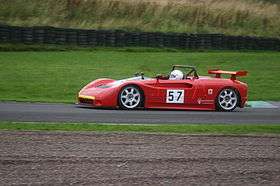Maserati Barchetta
| Maserati Barchetta | |
|---|---|
 | |
| Overview | |
| Manufacturer | Maserati |
| Also called |
Barchetta Corsa (racing) Barchetta Stradale (road) one unit only |
| Production |
1991-1992 (17 units) |
| Designer | Carlo Gaino (Synthesis Design) |
| Body and chassis | |
| Body style | 2-door roadster |
| Related | De Tomaso Guarà |
| Powertrain | |
| Engine | 90° 1996 cc mid-engined V6, 4-ohc, 24-valve, electronic fuel injection, twin water-cooled IHI turbochargers (RHB 5.2) |
| Transmission | ZF 6-speed transaxle, rear-wheel drive |
| Dimensions | |
| Wheelbase | 2,600 mm (100 in) |
| Length | 4,050 mm (159 in) |
| Width | 1,965 mm (77.4 in) |
| Height | 930 mm (37 in) |
| Curb weight | 905 kg (1,995 lb) |
The Maserati Barchetta was a mid-engined, two-door, two-seat sports car,[1] like the 350 and 450S, that was designed by Carlo Gaino[2][3] of the "Synthesis Design",[4] an Italian design house.
Thirteen examples of the racing model[5] were produced at De Tomaso's factory in Modena, plus two prototypes (one racing-corsa, one street-stradale). It featured a mid-engine V6 AM501 Maserati biturbo engine 1996cc (red intake manifold for the Corsa) an evolution of the AM490 (black intake manifold used for the Stradale), a central frame holding an integral fuel tank and a very light glass fiber/carbon fiber spyder body, accelerating the car to about 180 mph (290 km/h). The development of a road version was stopped at a late stage. However, today some racing cars hold a road title in Europe, after minor modifications to allow road compatibility.
The racing series Grantrofeo Barchetta[6] was held 1992 and 1993. It featured sixteen races in total, most of them in Italy.
The central-frame concept survived in the De Tomaso Guarà, but the frame was around 13 cm (5.1 in) longer because it was engined by a longer V8.
This was thought as a way to inject much needed excitement and enthusiasm for Maserati that saw its reputation badly ruined by years of exciting but maintenance sensitive products,[7] eventually culminating in Maserati's withdrawal from the North American market at this time.
It is also true that the amount of delicate maintenance necessary to take care of these high output small engines was not compatible with the auto repair industry in several territories.
This model has become a collector item valued at several times its introduction price.
References
- ↑ Maserati since 1926 by Maurizio Tabucchi ed. ETAI
- ↑ (Italian) List of articles on Carlo Gaino involvement in projects at Synthesis Design
- ↑ (Italian) Carlo Gaino website
- ↑ "Synthesis design - Maserati Barchetta". Synthesisdesign.it. Retrieved 2009-12-31.
- ↑ "Panini Museum on". Maserati.com. Retrieved 2012-08-30.
- ↑ "Maserati Barchetta and Grantrofeo Monomarca". Maserati-indy.co.uk. Retrieved 2012-08-30.
- ↑ cf. e.g. Car & Driver, Dec. 1998 issue (Vol. 44, No.6), page 88
External links
- Official Maserati Barchetta page
- Synthesis Design/ Carlo Gaino designer of Maserati Barchetta
- Maserati Barchetta report QV500
- AM 501 Engine
- Maserati Barchetta
- Maserati Barchetta Stradale - Road version
- The Maserati Grantrofeo Barchetta Register at www.maserati-alfieri.co.uk